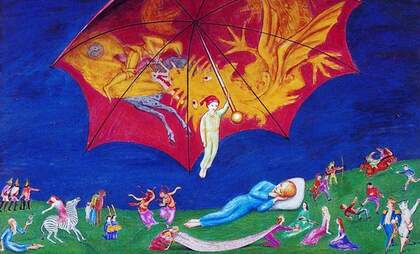Dutch Folklore: Klaas Vaak
Welcome back to another article on Dutch folklore. This week, we will take a look at a mythological character that, much like the Witte Wieven, doesn’t just appear in Dutch folklore but in much of Western and Northern European folklore. He is probably most popularly known as “The Sandman” but in Dutch, he is known as Klaas Vaak.
Enter Sandman
Klaas Vaak is a mythical old man, although sometimes he’s shown as a gnome or dwarf, who visits children during the night and sprinkle grains of sand into their eyes to make them sleep and have beautiful dreams. He is said to live on the moon and is often shown flying down through the use of an umbrella, which he carries two of – one that is filled with pictures to inspire vivid, beautiful dreams in good children and the other is blank, so as to make naughty children sleep heavily through the night with no dreams at all.
In some folk tales, he wants to tell children his stories but only tells his stories when children are quiet. So, to get them to be quiet, he creeps into their bedrooms and blows sand into their eyes so that they close and are unable to see him. He then blows on their necks until their heads begin to droop and, when they have finally fallen silent, he whispers his amazing stories to them. These stories are said to inspire the most amazing dreams of sleeping children.
Much like the Witte Wieven, the Sandman, while primarily known as a benevolent spirit, can pose a danger to humans and cause them serious harm. In the 1816 short story by German author, E. T. A. Hoffmann, Der Sandmann, the Sandman throws sand into the eyes of children who cannot sleep. This causes their eyes to fall out so that the Sandman can collect them and feed them to his children on the Moon.
Those who are visited by Klaas Vaak can often tell by the grains of sand (rheum) that are left clinging to their eyes when they awake.
World-renowned legend
The sandman is a popular and ever-present figure in European folklore and stories that were propagated by foreign authors were translated into many different languages, which helped spread the tales of the Sandman all around Europe.
For example, one of the most famous stories about the Sandman is called Ole Lukøje by the great Hans Christian Andersen. Ole Lukøje is the name Andersen gave to his Sandman character, which is translated to Klaas Vaak in Dutch.
Essentially, while a number of different stories refer to the Sandman by different names, they are usually attributed to the same mythical figure. In Norway or Sweden, he is called John, or Jon Blund, while in Denmark he is still commonly known as Ole Lukøje and in Dutch, or even Afrikaans, he is referred to as Klaas Vaak.
The Sandman’s legacy has permeated pop culture throughout history and continues to do so today. Whether it be through songs like Pat Ballard’s classic “Mr Sandman,” or influencing characters in TV shows, movies or comic books, the Sandman still captivates people’s imagination.
Klaas Vaak and Hjalmar
Hans Christian Andersen’s story about the Sandman and his visits to a young lad called Hjalmar remains, to this day, one of the most popular stories about the mythical figure. It tells the story of when Klaas Vaak visits Hjalmar every night for a week and the dreams Hjalmar has.
On Monday, Klaas Vaak enters Hjalmar’s room and turns the potted plants into sweet-smelling trees, adorned with golden fruit. He also hears Hjalmar’s school books complaining to him because they are filled with wrong answers and bad handwriting, Klaas Vaak corrects the mistakes. However, when Hjalmar wakes up, he finds the work has gone back to its original state.
On Tuesday, Klaas Vaak magically transports Hjalmar into a painting in his bedroom. In his dream, Hjalmar gets into a boat and sails down a river where he sees castles, princesses and toy soldiers. He then sails to his old town and visits his old wet nurse.
On Wednesday, when it is raining heavily, Klaas Vaak takes Hjalmar onto a lake that has been formed by the rainwater. They sail out to sea, where a stork flying overhead falls onto their boat. A sailor puts the bird into a henhouse with hens, ducks and guinea fowl, who make fun of the stork. Hjalmar eventually frees the bird from the cage, which gratefully flies off.
On Thursday, Hjalmar is invited to the wedding of two mice. Klaas Vaak magically shrinks Hjalmar so he can attend. He is dressed in the clothes of one of his toy soldiers and watches as the two mice tie the knot. He is then served a pea, which represents the wedding cake.
On Friday, Klaas Vaak arrives to tell Hjalmar a story. He tells Hjalmar that many adults have trouble sleeping, especially those who have sinned. Klaas Vaak explains that when adults sleep, their sins take the form of goblins that splash water into their eyes, stopping them from being able to rest.
He tells Hjalmar that many adults call for his help and even leave money out for him, but he can only help children sleep. Klaas Vaak also takes Hjalmar, which he himself performs, to another wedding during the night, this time between two of Hjalmar’s sister’s dolls.
On Saturday night, Klaas Vaak tells Hjalmar he cannot stay for too long, as he has to take the stars from the sky and clean them. A portrait of Hjalmar’s great-grandfather hears this and scoffs, telling Hjalmar you cannot take the stars from the sky.
Klaas Vaak replies, telling Hjalmar’s great-grandfather that, while he is old and wise, Klaas Vaak himself is older and wiser, revealing that he was known to the Ancient Greeks and Romans.
On Sunday night, Klaas Vaak tells Hjalmar to look out the window. He points out his brother, who is also called Klaas Vaak, riding a horse through the night sky. Klaas Vaak tells Hjalmar that his brother is also known as Death and, unlike his brother, Death only knows two stories and only visits people once in their life.
Klaas Vaak tells Hjalmar that if you lead a good life, you will hear Death’s beautiful story if not, you are told his horrifying tale. The story concludes with Klaas Vaak telling Hjalmar he need not be afraid of death if he leads a good life.
On to next week
Well, I hope you’ve enjoyed learning about Klaas Vaak and hearing one of the many stories that have perpetuated over the years about this legendary figure. Hopefully, it has inspired you to make positive changes so you can sleep without Klaas Vaak’s help and eventually hear Death’s beautiful story.



COMMENTS
Leave a comment